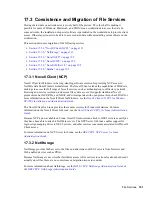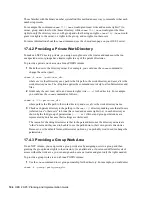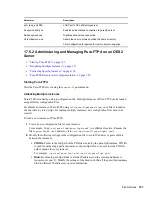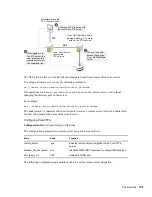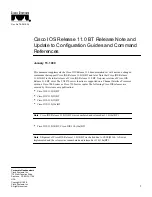
File Services
195
where
group
is the group name,
path
is the file path to the work area, and
group_dir
is the
group work directory. The
-R
option applies the action to all subdirectories and files in
group_dir.
2
Grant the group read, write, and execute rights (. . . rwx . . .). (Owner and other permissions are
represented by dots because their settings are irrelevant.)
For example, you could enter
chmod -R 770 /
path
/
group_dir
where
path
is the file path to the work area, and
group_dir
is the group work directory. The
second 7 grants rwx to the group. (The example assumes that the owner of the directory should
also retain all rights. Therefore, the first number is also 7.)
3
Check each parent directory in the path up to the
root (/)
directory, making sure that the
group has read and execute rights (r-x) in each directory as shown by the second group of
permissions ( . . . r-x . . .).
Use the
chmod
command to adjust this where necessary by specifying the number 5 for the
group permission. For more information, see “
Section 17.4.1, “Managing Access Rights,” on
page 193
.”
17.4.4 Providing a Public Work Area
On an NCP volume, you can provide a public work area by assigning [Public] as a trustee and then
granting the required trustee rights to the directory.
For the work area itself, you would set permissions for the owner, group, and all others to read,
write, and execute rights (rwx rwx rwx) (
chmod 777
).
All others must also have read and execute rights on the system in each parent directory in the path
all the way to the root of the Linux system. This means that you set permissions for all parent
directories to rwx --- r-x.
To provide a public work area on a Linux POSIX volume:
1
Use the
chown
command to assign all rights (rwx) to other (all users). For example, you could
enter
chmod -R 707 /
path
/
group_dir
where
path
is the file path to the work area, and
group_dir
is the group work directory. The
third 7 grants rwx to the group. (The example assumes that the owner of the directory should
also retain all rights and that the group setting is irrelevant.)
2
Check each parent directory in the path up to the
root (/)
directory, making sure that all users
(other) have read and execute rights (r-x) in each directory as shown by the third group of
permissions (. . . . . . rwx). (Owner and group permissions are represented by dots because their
settings are irrelevant.)
Use the chmod command to adjust this where necessary by specifying the number 5 for the
other permission. For more information, see “
Managing Access Rights
” at the beginning of this
section.
Summary of Contents for OPEN ENTERPRISE SERVER - CONVERSION GUIDE 12-2010
Page 12: ...12 OES 2 SP3 Planning and Implementation Guide...
Page 24: ...24 OES 2 SP3 Planning and Implementation Guide...
Page 50: ...50 OES 2 SP3 Planning and Implementation Guide...
Page 74: ...74 OES 2 SP3 Planning and Implementation Guide...
Page 78: ...78 OES 2 SP3 Planning and Implementation Guide...
Page 80: ...80 OES 2 SP3 Planning and Implementation Guide...
Page 96: ...96 OES 2 SP3 Planning and Implementation Guide...
Page 146: ...146 OES 2 SP3 Planning and Implementation Guide...
Page 176: ...176 OES 2 SP3 Planning and Implementation Guide...
Page 210: ...210 OES 2 SP3 Planning and Implementation Guide...
Page 218: ...218 OES 2 SP3 Planning and Implementation Guide...
Page 226: ...226 OES 2 SP3 Planning and Implementation Guide...
Page 234: ...234 OES 2 SP3 Planning and Implementation Guide...
Page 236: ...236 OES 2 SP3 Planning and Implementation Guide...
Page 244: ...244 OES 2 SP3 Planning and Implementation Guide...
Page 246: ...246 OES 2 SP3 Planning and Implementation Guide...
Page 250: ...250 OES 2 SP3 Planning and Implementation Guide...
Page 254: ...254 OES 2 SP3 Planning and Implementation Guide...
Page 258: ...258 OES 2 SP3 Planning and Implementation Guide...
Page 284: ...284 OES 2 SP3 Planning and Implementation Guide...
Page 286: ...286 OES 2 SP3 Planning and Implementation Guide...
Page 294: ...294 OES 2 SP3 Planning and Implementation Guide...











